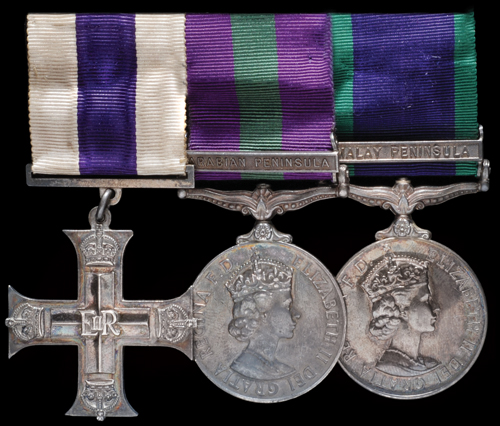
Auction: 9004 - Orders, Decorations, Campaign Medals and Militaria
Lot: 947
The Fine ´1955´ Immediate ´Buraimi Operations, Arabian Peninsula´ M.C. Group of Three to Major A.R. Steggles, Royal Artillery, Who Led His Squadron of Trucial Oman Levies During the Attack on the Internationally Disputed Saudi Held Position of Hamasa, 26.10.1955, and ´On Two Occasions He Approached to Within Short Range of One of the Strongly Manned Forts of the Enemy to Use the Two-Inch Mortar Against It.´ a) Military Cross, E.II.R., reverse officially dated ´1956´ b) General Service 1918-62, E.II.R., one clasp, Arabian Peninsula (Major A.R. Steggles. M.C. R.A.) c) General Service 1962-2007, one clasp, Malay Peninsula (Capt. A.R. Steggles. M.C. RA.), darkly toned, light contact marks, therefore very fine, mounted as originally worn, with photograph of recipient and recruits of the Trucial Oman Scouts on their Passing Out Parade (3) Estimate £ 8,000-12,000 M.C. London Gazette 29.5.1956 Captain Anthony Richard Steggles (379351), Royal Regiment of Artillery. (Employed List 3.) ´´In recognition of gallant and distinguished services in the Trucial Oman.´´ The Recommendation states: ´´Place: Hamasa, Buraimi Oasis, Trucial States. Date of Action: 26 October 1955. How employed: as a Squadron Commander, Trucial Oman Levies. Other Detail: This officer led the Squadron in the attack on Hamasa on 26 October 1955. Throughout the initial heavy fighting which lasted from 0530 hours until midday without ceasing, and thereafter at intervals throughout the remainder of the day he displayed at all times coolness of mind; steadiness of action and high standard of personal courage. By his bearing and leadership he rallied his troops after their first casualties, drawing from them their utmost efforts throughout the battle. He dragged one of his wounded men lying in the open through close rifle fire of about two minutes´´ duration to safety; with no regard for his own personal safety. On two occasions he approached to within short range of one of the strongly manned Forts of the enemy to use the two-inch mortar against it, on both occasions putting himself completely exposed to the fire of the enemy. His courage under fire and his command and leadership of his Arab Warrant Officer, Non Commissioned Officers and men in their first major operation was an important factor in the final success of the Buraimi Operations.´´ Major Anthony Richard Steggles, M.C., commissioned Lieutenant Royal Artillery, 27.10.1948; Steggles arrived for the first of two tours of the Trucial States, on the Persian Gulf, in May 1953; he was attached, initially as Adjutant, to the Trucial Oman Levies. The Trucial Oman Levies (TOL) were initially raised in 1951, ´´as an armed gendarmerie to police the Trucial States of the Gulf´´ (Two Alpha Lima, P. Clayton refers). In 1952 there was an incursion from Saudi Arabia into the Buraimi Oasis, Hamasa, a disputed area. As a consequence the TOL Operational Directive at the time became, ´´to prevent arms, ammunition, supplies and re-inforcements from entering the territory of the Trucial States and to blockade the Saudis in Hamasa´´ (Ibid). The ´´Buraimi Dispute´´ was continue for another three years before decisive action was taken by the British on the 26th October 1955. In the lead up to the re-occupation of Hamasa Steggles held various appointments with the TOL and was heavily involved with the policing in and around the area. In July 1953, ´´Captain Steggles, RSM Daud Sidqi and about eight men were flown in an Anson aircraft into Arada airstrip in the western end of the Liwa. Their task was to move that post to Humar and there to lay out another airstrip. It took them about three weeks to complete the task in midsummer using camels for transport. The Humar Post was left under command of Mulazim Abdullah Hussain who had served his time with the APL camel patrols. Captain Steggles, RSM Daud and six men with a local guide travelled by camel the length of the Liwa to Al Khis where there was another small TOL post with a radio station. From here they set out for Buraimi and were out of radio contact for the week it took them to reach the Squadron HQ in Murabba´´ Zayed. This was a remarkable exploit even for the local Bedu who would have avoided travelling these distances by camel in midsummer.´´ (Ibid). The following month Steggles was to return to Sharjah and take up his new appointment as Motor Transport Officer (MTO). There were frequent incidents of blockade running but by July of the following year the efficiency of the blockade had been greatly improved with four blockade runners being shot and two captured in that month alone. However it appeared that Saudi money was continuing to be used for bribery in an attempt to effect the overthrow of the ruler of Abu Dhabi. On the 30th July in Jeddah, ´´the Saudi Arabian and British Governments agreed to refer the ´´Buraimi Dispute´´ to arbitration by international tribunal. The main terms of this agreement were that the Saudi party under Turki bin Ataishan was to leave Hamasa and return to Saudi Arabia; the TOL squadron that had been surrounding it in Hamasa was to withdraw from the Buraimi Oasis; the country west and south of a line from Mirfa to Buraimi was territory under dispute; and that the TOL were to be reduced in strength by one squadron. A neutral zone of 15 miles radius, with its centre on Buraimi village, was to be policed by a joint force of 15 all ranks from the TOL with a similar number from Saudi Arabia and both sides were to refrain from any activity which would change the situation existing at that time.´´ (Ibid) What was created was an uneasy ´´Neutral Zone´´ whose policing and actions were strictly controlled by London on one side and Dammam on the other. In September 1954 Steggles took command of C Squadron, then posted at Kahil. Incidents of banditry funded and non-funded by the Saudis were frequent and occupied much of the TOL´´s time and resources. Three posts were set up in the Wadi Quar area to combat the rise in number of such incidents. On the 25th of October, ´´the Wali from Sohar and some of his askaris, escorted by most of C Squadron under Captain Steggles, were moving into the area of Khatwa when a civilian refused to stop when challenged by the Wali´´s men. He was shot dead and was found to be carrying messages from Hamasa to Khatwa. C Squadron made a frontal attack on the village supported by Bani Ka´´ab tribesmen loyal to Abdullah bin Salim. The action was successful and Obaid bin Juma´´s men dispersed to thier villages.´´ (Ibid) One of Steggles´´ Levies was killed in the attack. In September 1955 the dispute went to another arbitrational hearing, this time in Geneva. Four of the five members of the tribunal resigned in protest at the Saudi activities and infringements of the agreement that had been put in place by the last tribunal hearing. It was stipulated that continued bribery and intimidation were being employed in an effort to overthrow the then ruler of Abu Dhabi. As the tribunal collapsed it was decided that the Saudis would have to be forcibly removed from Buraimi. It was not long before this decision from London was acted upon and on the 26th October Steggles (see M.C. Citation) was to play a substantial role in the operations against the Saudis in the Buraimi Oasis. Two Alpha Lima offers further incite: ´´On 24 October, A and C Squadrons concentrated at Burj Obaid and Kahil respectively. There they were joined by Lieutenant-Colonel Johnson and a small tactical headquarters which included Major Little. A series of false radio messages provided a deception plan that covered the movement of troops and vehicles from Sharjah. Before dawn on 25 October, A Squadron, under Captain Rhodes accompanied by Major Smith, drove into the Neutral Zone to the joint Buraimi Police location and arrested the Saudi party with only one shot being fired..... Also at dawn, C Squadron, commanded by Captain Steggles and accompanied by Captain Laird, entered Hamasa from the north-west and captured Bait Turki.... The sound of vehicles and rifle shots brought a number of villagers into the open, some believing that it was the Saudis who had returned. The sight of Captain Steggles coming out of Bait Turki brandishing a Bren gun soon made things clear. Leaving Sergeant Mohammed Nakhaira, Levies Abdulla Rashid al Dahari, Salim Said al Kaabi and another Kaabi to hold Bait Turki, Captain Steggles, with the other troop under Sergeant Nakhaira Mohammed al Jibhouni and Squadron HQ with Squadron Sergeant Major Ali Salim Nayadi, moved into Bait bin Karam and Bait Abdulrahman al Aiami nearby......... The vehicles that had been left in the open had come under fire from Burj al Alam which was some way to the south-west, and another building some 100 yards to the north. The radio vehicle had been shot-up and the set destroyed, the ammunition truck, however, was collected under fire by Driver Lance Corporal Said Salim Si´´ar and brought to shelter. Captain Laird´´s Landrover was driven on this operation by Driver Khilfan Matr al Rumaithi. Captain Steggles attempted to neutralise the rifle-fire coming from Bati Aqeel by using the two-inch mortar firing HE and smoke bombs. By now C Sqaudron was confined to the buildings by fire coming from Burj al Ajam to the west and Bait Aqeel to the north. They had lost one man shot dead, Jundi Obaid Mubarek al Katabi, shot through the head and Jundi Sayid al Hadhrami had been mortally wounded in the abdomen while climbing over a wall. He had been rescued by Captain Steggles and driven out under fire to the medical post in a Landrover by Lance Corporal Said Salim Si´´ar, who then returned to Hamasa again under fire. By midday the situation had stabilised..... Sergeant Mohammed Nakhaira´´s group left in Bait Turki were exchanging fire with Bait Rashid bin Ahmed and Bait Abdulaziz throught that day and into the night. Their ammunition supply had run low before they discovered many sacks of rice recently delivered by air to the Saudis which contained large quantities of .303 ammunition. So this small party were able to keep up a remarkable intensity of fire throughout the action.´´ Just after midnight the Saudis, under Shaikh Rashid bin Hamed al Shamisi, his brother, and Shaikh Obaid bin Juma al Ka´´abi, asked to surrender. They had been unable to cope with the surprise and intensity of fighting provided by the British led TOL. In May 1956 an investiture for the awards won during the operations at Buraimi was held at Sharjah. The awards, including Steggles M.C., were presented in the absence of the Queen by the Political Resident Sir Bernard Burrows. Steggles had also received a field promotion to Major after his gallant leadership at the Buraimi Oasis. Other awards for this action were an O.B.E. and three Military Medals.
Sold for
£40,000




